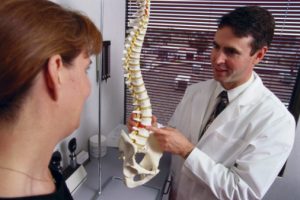Back Pain
Back Pain
Although doctors of chiropractic (DCs) treat more than just back pain, many patients initially visit chiropractors looking for relief from this pervasive condition. In fact, 31 million Americans experience low-back pain at any given time.1
Some interesting facts about back pain:
Low back pain is the single leading cause of disability worldwide, according to the Global Burden of Disease 2010.
Back pain is one of the most common reasons for missed work. In fact, back pain is the second most common reason for visits to the doctor’s office, outnumbered only by upper-respiratory infections.
One-half of all working Americans admit to having back pain symptoms each year.2
Experts estimate that as much as 80% of the population will experience a back problem at some time in their lives.3
Most cases of back pain are uncomplicated, i.e. mechanical or non-organic—meaning they are not caused by serious conditions, such as inflammatory arthritis, infection, fracture, tumor or cancer.
Americans spend at least $50 billion each year on back pain—and that’s just for the more easily identified costs.4
What Causes Back Pain?
The back is a complicated structure of bones, joints, ligaments and muscles. Sudden, uncontrolled and unprotected movements can easily sprain ligaments, strain muscles, rupture disks, and irritate joints, all of which can lead to back pain. While sports injuries or accidents can cause back pain, sometimes the simplest unprotected movement—for example, picking up a pencil from the floor— can have painful results. In addition, arthritis, poor posture, obesity, and psychological stress can cause or complicate back pain. Back pain can also directly result from disease of the internal organs, such as kidney stones, kidney infections, blood clots, or bone loss.
Manipulation as a Treatment for Back Problems
Used primarily by DCs for the past century, spinal manipulation has been largely ignored by most others in the health care community until recently. Now, with today’s growing emphasis on treatment and cost effectiveness, spinal manipulation is receiving more widespread attention.
Spinal manipulation is a safe and effective spine-pain treatment. It reduces pain (decreasing the need for medication in some cases), rapidly advances physical therapy, and requires minimal passive forms of treatment, such as bed rest.5
In fact, after an extensive study of all available care for low back problems, the federal Agency for Health Care Policy and Research (now the Agency for Health Care Research and Quality) strongly recommended that low back pain sufferers choose the most conservative care first. And it recommended spinal manipulation as the only safe and effective, drugless form of initial first-line professional treatment for acute low back problems in adults.6
A well respected review of the evidence in the Annals of Internal Medicine pointed to chiropractic care as one of the major non-pharmacologic therapies considered effective – and safest – for acute and chronic low back pain.7
More recently, research has shown that there is strong evidence that spinal manipulation for back pain is just as effective as a combination of medical care and exercise, and moderate evidence that it is just as effective as prescription NSAIDS combined with exercise.8 It is, by far, the safest method of first-line treatment for uncomplicated back pain, inasmuch as NSAIDS can cause internal bleeding as well as perforation of the stomach lining/wall.
A patient information article published in the Journal of the American Medical Association in 2013 also suggested chiropractic care as an option for people suffering from low back pain–and noted that surgery is usually not needed and should only be resorted to only if other conservative therapies fail.9
The preponderance of scientific thinking now urges back pain sufferers to make an informed choice about your back care. There are over 600,000 fusion surgeries undertaken yearly in the United States and approximately 74% of them are unsuccessful.10
To learn more about how the services of doctors of chiropractic may help you, review the results of recent research studies and contact a doctor of chiropractic in your area that is a member of and subscribes to the professional standards mandated by the Indiana State Chiropractic Association.
- Tips to Prevent Back Pain
- Maintain a healthy diet and weight.
- Remain active—under the supervision of your doctor of chiropractic.
- Avoid prolonged inactivity or bed rest.
- Warm up or stretch before exercising or physical activities, such as gardening.
- Maintain proper posture.
- Wear comfortable, low-heeled shoes.
- Sleep on a mattress of medium firmness to minimize any curve in your spine.
- Lift with your knees, keep the object close to your body, and do not twist when lifting.
- Quit smoking. Smoking impairs blood flow, resulting in oxygen and nutrient deprivation to spinal tissues.
- Work with your doctor of chiropractic to ensure that your computer workstation is ergonomically correct.
References:
1. Jensen M, Brant-Zawadzki M, Obuchowski N, et al. Magnetic Resonance Imaging of the Lumbar Spine in People Without Back Pain. N Engl J Med 1994; 331: 69-116.
2. Vallfors B. Acute, Subacute and Chronic Low Back Pain: Clinical Symptoms, Absenteeism and Working Environment. Scan J Rehab Med Suppl 1985; 11: 1-98.
3. Ibid.
4. In Project Briefs: Back Pain Patient Outcomes Assessment Team (BOAT). In MEDTEP Update, Vol. 1 Issue 1, Agency for Health Care Policy and Research, Rockville, MD.
5. Time to recognize value of chiropractic care? Science and patient satisfaction surveys cite usefulness of spinal manipulation. Orthopedics Today 2003 Feb; 23(2):14-15.
6. Bigos S, Bowyer O, Braen G, et al. Acute Low Back Problems in Adults. Clinical Practice Guideline No.14. AHCPR Publication No. 95-0642. Rockville, MD: Agency for Health Care Policy and Research, Public Health Service, U.S. Department of Health and Human Services, December, 1994.
7. Chou R, Hoyt Huffman LH. Nonpharmacologic therapies for acute and chronic low back pain: a review of the evidence for an American Pain Society/American College of Physicians Clinical Practice Guideline. Ann of Internal Med 2 Oct. 2007;147(7):492-504.
8. Bronfort G, Haas M, Evans R, et al. Evidence-informed management of chronic low back pain with spinal manipulation and mobilization. Spine. 2008;8(1)213-225.
9. Goodman D, Burke A, Livingston E. Low Back Pain. JAMA. 2013; 309(16):1738
10. Nguyen TH, Randolph DC, Talmage J, Succop P, Travis R. Long-term Outcomes of Lumbar Fusion Among Workers’ Compensation Subjects: An Historical Cohort Study; Spine (Phila Pa 1976) 2011 (Feb 15); 36 (4): 320–331



